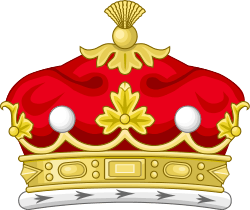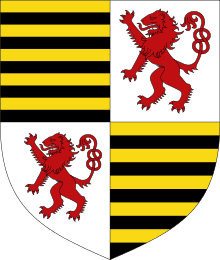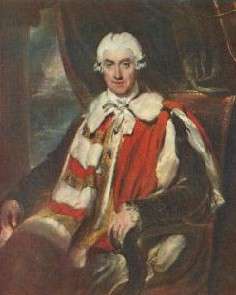Marquess of Bath
| Marquessate of Bath | |
|---|---|
|
Quarterly: 1st and 4th, barry of ten Or and Sable (Botteville); 2nd and 3rd, Argent, a lion rampant with tail nowed and erected Gules (Thynne).[1] | |
| Creation date | 18 August 1789 |
| Monarch | King George III |
| Peerage | Peerage of Great Britain |
| First holder | Thomas, Marquess of Bath |
| Present holder | Alexander, Marquess of Bath |
| Heir apparent | Ceawlin, Viscount Weymouth |
| Remainder to | heirs male of the body lawfully begotten |
| Subsidiary titles |
Viscount Weymouth Baron Thynne Baronet (of Caus Castle) |
| Seat(s) | Longleat |
Marquess of Bath is a title in the Peerage of Great Britain. It was created in 1789 for Thomas Thynne, Viscount Weymouth. The Marquess holds the subsidiary titles Baron Thynne, of Warminster in the County of Wilts, and Viscount Weymouth, both created in 1682 in the Peerage of England. He is also a baronet in the Baronetage of England.
Family history until 1800

The Thynne family descends from the soldier and courtier Sir John Thynne (died 1580), who constructed Longleat House between 1567 and 1579. In 1641 his great-grandson Henry Frederick Thynne was created a Baronet, of Caus Castle, in the Baronetage of England (some sources claim that the territorial designation is "Kempsford in the County of Gloucester"). He was succeeded by his son, the second Baronet. He represented Oxford University and Tamworth in the House of Commons and also served as Envoy to Sweden. In 1682 he was raised to the Peerage of England as Baron Thynne, of Warminster in the County of Wilts, and Viscount Weymouth, in the County of Dorset, with remainder to his younger brothers James Thynne (who died unmarried) and Henry Frederick Thynne and the heirs male of their bodies.
Lord Weymouth died without surviving male issue in 1714 (one of his three sons, the Honourable Henry Thynne, represented Weymouth and Melcombe Regis and Tamworth in Parliament but had died in 1708, leaving only daughters) and was succeeded in the peerages (according to the special remainders) by his great-nephew, the second Viscount. He was the grandson of the aforementioned Henry Frederick Thynne, brother of the first Viscount. He married as his second wife Lady Louisa Carteret, daughter of John, Earl Granville, a female-line grandson of John, Earl of Bath (a title which had become extinct in 1711). Lord Weymouth was succeeded by his eldest son, the third Viscount. He was a prominent statesman and served as Secretary of State for the Northern Department and as Secretary of State for the Southern Department. In 1789 the Bath title held by his ancestors was revived when he was created Marquess of Bath.
Family history 1800-present
His son, the second Marquess, sat as Tory Member of Parliament for Weobley and Bath and served as Lord-Lieutenant of Somerset. His eldest son Thomas Thynne, Viscount Weymouth, represented Weobly in Parliament but predeceased his father by two months. Lord Bath was therefore succeeded by his second son, the third Marquess, who died three months later. He was a Captain in the Royal Navy and also sat as Member of Parliament for Weobly. His son, the fourth Marquess, succeeded at age six; he was Chairman of the Wiltshire County Council and Lord-Lieutenant of Wiltshire. He was succeeded by his eldest son, the fifth Marquess. He was a Conservative politician and served briefly as Under-Secretary of State for India in 1895. His second but eldest surviving son, the sixth Marquess, represented Frome in the House of Commons as a Conservative. The titles are currently held by the latter's second but eldest surviving son, the seventh Marquess, who succeeded in 1992. He is a well-known politician, author and artist. In 2015 the Times described him as "a steaming pile of ancient kaftans and one of our wuffliest and weirdest mad-hatter aristocrats. He is best known for swanning around Longleat, his enormous Elizabethan pad in Wiltshire, entertaining his 75 concubines, or as he calls them, “wifelets”. The wifelets have included former Bond girls and Sri Lankan teenagers, as well as housewives and, according to some, in a couple of unfortunate cases actual prostitutes. The deal is simple: the wifelets get to hang out with Lord Bath in a jewel of a palace and in return he gets unlimited sex."[2]
Other family members

The Honourable Henry Thynne, second son of the second Viscount, succeeded to the Carteret estates through his mother and assumed the surname of Carteret in lieu of Thynne. In 1784 he was created Baron Carteret with remainder to the younger sons of his brother the first Marquess of Bath (see the Baron Carteret for more information on this title). Several other members of the Thynne family have also gained distinction. The Reverend Lord John Thynne, third son of the second Marquess, was sub-Dean of Westminster Abbey; his seventh son was Major-General Sir Reginald Thomas Thynne (1843–1926). Lord Henry Thynne, second son of the third Marquess, was a Conservative politician and notably served as Treasurer of the Household from 1875 to 1880. Lord Alexander Thynne, third son of the fourth Marquess, represented Bath in the House of Commons from 1910 to 1918.
The family seat is Longleat House.
Coat of arms
The arms borne by the Thynne family are: Quarterly: 1st and 4th, barry of ten Or and Sable (Botteville); 2nd and 3rd, Argent, a lion rampant with tail nowed and erected Gules (Thynne).[1] This can be translated as: a shield divided into quarters, the top left and bottom right made of ten horizontal bars alternating gold and black (for the Boteville family); the top right and bottom left quarters white with a red lion rampant with a knotted tail (for the Thynne family).
Early Thynnes of Longleat
- Sir John Thynne the Elder (1515–1580), the builder of Longleat
- Sir John Thynne the Younger (1555–1604), son of Sir John Thynne the Elder
- Sir Thomas Thynne (ca. 1578–1639), son of Sir John Thynne the Younger
- Sir James Thynne (1605–1670), son of Sir Thomas Thynne
- Thomas Thynne (1648–1682), nephew of Sir James Thynne, grandson of Sir Thomas Thynne.
Thynne Baronets, of Cause Castle (1641)
- Sir Henry Frederick Thynne, 1st Baronet (1615–1680), son of Sir Thomas Thynne (ca. 1578–1639)
- Sir Thomas Thynne, 2nd Baronet (1640–1714) (created Viscount Weymouth in 1682)
Viscounts Weymouth (1682)
- Thomas Thynne, 1st Viscount Weymouth (1640–1714)
- Hon. Henry Thynne (1675–1708)
- Thomas Thynne, 2nd Viscount Weymouth (1710–1751)
- Thomas Thynne, 3rd Viscount Weymouth (1734–1796) (created Marquess of Bath in 1789)
Marquesses of Bath (1789)
- Thomas Thynne, 1st Marquess of Bath (1734–1796)
- Thomas Thynne, 2nd Marquess of Bath (1765–1837)
- Henry Frederick Thynne, 3rd Marquess of Bath (1797–1837)
- John Alexander Thynne, 4th Marquess of Bath (1831–1896)
- Thomas Henry Thynne, 5th Marquess of Bath (1862–1946)
- Henry Frederick Thynne, 6th Marquess of Bath (1905–1992)
- Alexander George Thynn, 7th Marquess of Bath (b. 1932)
The heir apparent is the present holder's son Ceawlin Henry Laszlo Thynn, Viscount Weymouth (b. 1974).
The heir apparent's heir is his son the Hon. John Alexander Ladi Thynn (b. 2014).
See also
Notes
- 1 2 Montague-Smith, P.W. (ed.), Debrett's Peerage, Baronetage, Knightage and Companionage, Kelly's Directories Ltd, Kingston-upon-Thames, 1968, p.119
- ↑ London Sunday Times 6 Sept 2015
- ↑ Burke, Sir Bernard, (1938 ed) Burke's Peerage, Baronetage and Knightage. Shaw, London. p.243
- 1 2 3 Woodfall, H. (1768). The Peerage of England; Containing a Genealogical and Historical Account of All the Peers of that Kingdom Etc. Fourth Edition, Carefully Corrected, and Continued to the Present Time, Volume 6. p. 258.
- 1 2
 Lee, Sidney, ed. (1898). "Thynne, William". Dictionary of National Biography. 56. London: Smith, Elder & Co.
Lee, Sidney, ed. (1898). "Thynne, William". Dictionary of National Biography. 56. London: Smith, Elder & Co. - ↑ Girouard, Mark, Thynne, Sir John (1515–1580), estate manager and builder of Longleat in Oxford Dictionary of Biography (Oxford University Press, 2004)
- ↑ Booth, Muriel. "THYNNE, John (?1550-1604), of Longleat, Wilts.". History of Parliament. The History of Parliament Trust. Retrieved 2 January 2016.
- ↑ Lancaster, Henry; Thrush, Andrew. "THYNNE, Charles (c.1568-1652), of Cheddar, Som.". History of Parliament. The History of Parliament Trust. Retrieved 2 January 2016.
- ↑ Rugh, R. B.; Critall, Elizabeth. "'Parliamentary history : 1529-1629', in A History of the County of Wiltshire: Volume 5". British History Online. Victoria County History. Retrieved 2 January 2016.
- ↑ Ferris, John P. "THYNNE, Sir James (c.1605-70), of Longbridge Deverill, Wilts.". History of Parliament. The History of Parliament Trust. Retrieved 2 January 2016.
- ↑ Helms, M. W.; Ferris, John P. "THYNNE, Sir Thomas (c.1610-c.69), of Richmond, Surr.". History of Parliament. The History of Parliament Trust. Retrieved 2 January 2016.
- ↑ Marshall, Alan. "Thynne, Thomas". Oxford Dictionary of National Biography. Retrieved 2 January 2016. (subscription required (help)).
- ↑ Heath-Caldwell, J. J. "Thomas Thynne, 1st Marquess of Bath, 3rd Viscount Weymouth". JJ Heath-Caldwell. Retrieved 2 January 2016.
- ↑ Hayton, D. W. "THYNNE, Hon. Henry (1675-1708).". The History of Parliament. The History of Parliament Trust. Retrieved 2 January 2016.
- ↑ Dunaway, Stewart (2013). Lord John Carteret, Earl Granville - His Life History and the Granville Grants. Lulu. p. 33. ISBN 9781300878070.
- ↑ "Bath, Thomas Thynne". Encyclopedia Britannica 1911. Retrieved 2 January 2016.
- ↑ Thorne, Roland. "Carteret [formerly Thynne], Henry Frederick". Oxford Dictionary of National Biography. Retrieved 2 January 2016.
- ↑ "Thomas Thynne, 2nd Marquess of Bath (1765-1837)". National Portrait Gallery. Retrieved 2 January 2016.
- ↑ Escott, Margaret. "THYNNE, Lord Henry Frederick (1797-1837), of 6 Grovesnor Square, Mdx.". History of Parliament. The History of Parliament Trust. Retrieved 2 January 2016.
- ↑ "John Thynne, 4th Marquess of Bath (1831-1896), Diplomat and landowner". National Portrait Gallery. Retrieved 2 January 2016.
References
- Kidd, Charles, Williamson, David (editors). Debrett's Peerage and Baronetage (1990 edition). New York: St Martin's Press, 1990.
- Leigh Rayment's Peerage Pages
- Lundy, Darryl. "FAQ". The Peerage.
- Wyn Ellis, Nesta. The Marquess of Bath: Lord of Love. Dynasty Press, 2010. ISBN 978-0-9553507-4-0
External links
- Official website of the 7th Marquess of Bath


